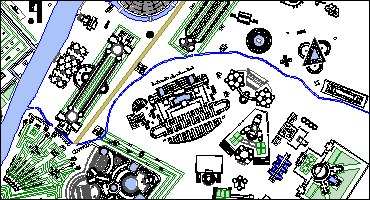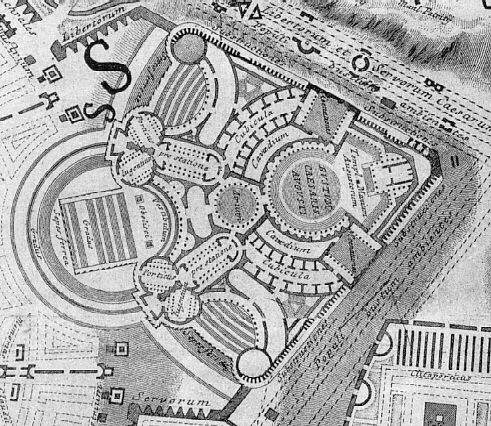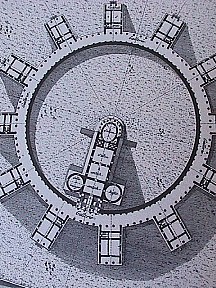1956
Vincenzo Fasolo, "The Campo Marzio of G. B. Piranesi".
2691a
2691c
2691e
1995.01.11
relation of past and present site placement
There is a connection between the existing remnants of the ancient wall in the vicinity of the P. del Popolo and Piranesi's Bustum Caesaris Augusti. There seems to have been, since ancient times, a large triangular formation in this region and Piranesi has used this ancient formation and created, in the Bustum Augusti, a very original design, and probably even an original program. This may be a good example where Piranesi used the reality of scant remains and metabolized the physical evidence into a rather overwrought architectural creation. It must be said, however, that the physical remains are large and this largeness of the triangular formation does suggest a rather large architectural complex. So, in that regard, Piranesi may be justified in his largeness (and overwroughtness of) "original reconstruction."
This example brings to mind the concept of degrees of separation within the degrees of representation. The Bustum Augusti is perhaps an example where there are a number of degrees of separation within the degrees of representation.
1996.09.02
Tafuri text
1997.08.23
Pictorial Dictionary notes
Horti Acilioium, Piranesi ignores this garden and instead elaborates the Horti Luciliani and the Bustum C. Augusti.
1998.01.15
places of Nero
Throughout this chapter I will call out the "presence" and significance of Nero. From the towers within his gardens (Piranesi's reference to Nero's watching the great fire of AD 60?) to the other Nero landmarks throughout the Ichnographia. Citing Suetonius as to the placing of Nero's ashes within the area of the Ichnographia's Bustum Augusti.
...read Tacitus' Annals as well. The ancient authors offer a wonderful resource with regard to who built what, and what existed when, and even who knocked down what.
1998.04.12
porticus display; typologies
...porticus... ...are such a distinctly Roman type. ...producing a land-use map.
...the phalic plan formations within the Bustum Augusti are labeled as porticus for the mourning of soldiers...
1998.04.23
the Ichnographia as "theme park"
...the notion of the Ichnographia being used (perhaps for the first time) as a "guide map." Using the Ichnographia as a guide would seem ridiculous to most because the large plan has always been dismissed as a pure fantasy. It can act as a guide, however, especially if one is aware of the textual background of the plan, meaning the historical texts which describe ancient Rome.
...looking at the Ichnographia as an ancient Roman theme park--a virtual place where one can vicariously experience the ancient city as well as learn about the history of the city.
The themes Piranesi uses are numerous:
a. the Imperial genealogy of both the Bustum Augusti and the Bustum Hadriani.
b. the forward and backward "ride" of the Triumphal Way.
c. the military themes along the Equiria.
d. the numerous garden designs
.
e. the nemus Caesarum.
The whole typological catalogue is nothing but one variation on a theme after another.
| |
1998.04.27
insights regarding the Campo Marzio Busti
...ideas regarding the Bustum Hadriani and the Bustum Caesaris Augusti. ...Piranesi treated them as opposites of each other.
...the radiation triangular clitoporticus of the Bustum Hadriani--a porticus dedicated to the evocation of the gods and the spirits of the lower world. Such a porticus fits perfectly on the axis of death, ...the meaning of the Bustum is burning place and there is the slab for the burning bodies and the funeral-pyre. The design of the clitoporticus directs all focus upon the place of burning, and it is easy to imagine the wailing that would emanate from this place--it is interesting to match the raising of wailing voices from the clitoporticus with the raising of smoke from the cavea bustum. The whole Bustum Hadriani is exceedingly morbid, and, ironically, it seems that the burning of the dead within the Bustum Hadriani is treated as a spectator sport, especially with the grandstands of the cavae bustum.
...in the Bustum Augusti there is the exact opposite wording--the joyful recollection of Augustus. ...all the other contrasts between the Bustum Hadriani and the Bustum Augusti:
...the Clitoporticus ab Hadriano funnels inward; the Nemus Caesarum fans outward.
...the Hadrian precinct is square, the Augustus precinct is round.
...the Bustum Hadriani is a depression; the Bustun Caesaris Augusti is raised on a hill.
...the center of the Bustum Hadriani is fire; the center of the Bustum Caesaris Augusti is water.
...the Bustum Hadriani is surrounded by a canal (moat); the Bustum Caesaris Augusti is surrounded by a wall.
...the Bustum Hadriani, with its circuses, is open to all; the Bustum Caesaris Augusti, with its iron gates, is closed.
...the Bustum Hadriani has some degree of archeological veracity; the Bustum Caesaris Augusti is full of blatant misplacements.
...Bustum Caesaris Augusti represents the "rise" of Rome, and the Bustum Hadriani represents the "fall" of Rome, ...another inversion derived from a whole set of inversions. The notion of "rise" can also be seen in the phallic porticus of the Bustum Caesaris Augusti.
1998.06.28
phone conversation with Sue Dixon
I spoke with Sue last Tuesday night, and it was the first time in several months--the first time since I did all the Latin translating. I told her practically everything new that I found and/or figured out, and a few ideas came out of the conversation as well.
1. the notion that the moat around the Bustum Hadriani could represent the limits that Hadrian himself put upon the Empire.
2. where the Bustum Hadriani is within square precinct limits, the Bustum Caesaris Augusti is outside circular precinct limits. This is another example of the two Busti being inversions of each other.
4. Sue had a clear notion of what Tafuri means with regard to Piranesi's loss of language, in that [Tafuri thought] Piranesi was engrossed in mere words (the individual plans of the Ichnographia) and thereby lost or disregarded the notion of composing cohesive sentences, i.e., a workable and properly planned urban design. We agree that Tafuri's interpretation is indeed wrong because Piranesi's plan is a dense and complex narrative.
1998.12.01
Petronia Amnis

The Petronia Amnis of the Ichnographia begins in the east and flows along the southern edge of the Hortulorum valley. Its northern bank in the valley contains the Sepulchrum Agrippae and the Sepulchrum Julii Ceasaris et Drusi, while its southern bank is the ridge of the hill on top of which is the Horti Lucullani and some Turres expugnandae (military assult towers). Eventually, the stream skirts the southern portion of the Equiria and the northern flank of the Bustum Augustii. Ultimately, the Petronia Amnis flows into the Tiber.
| |
The Petronia Amnis of the Ichnographia begins in the east within the valley of the Hortulorum, then skirts the northern flank of the Bustum Augustii, and eventually flows into the Tiber. Piranesi dislocates the Petronia Amnis from its original situation to a more northern position.
|
| |
2001.11.26
Piranesi's Continual Double Theaters
2005.04.29 12:59
Sexual Architecture??
Ledoux's proposed plan for a brothel for Chaux, which reenacts part of Piranesi's plan of the Bustum Caesaris Augusti within the Ichnographia Campus Martius.

Giovanni Battista Piranesi
Bustum Caesaris Augusti
within the Ichnographia Campus Martius
1757-62

Claude-Nicolas Ledoux
Maison de Plaisir
c. 1789
|

Claude-Nicolas Ledoux
Oikèma
1789
|
|